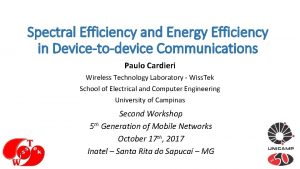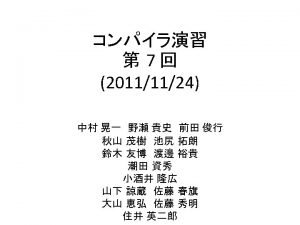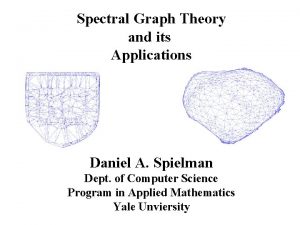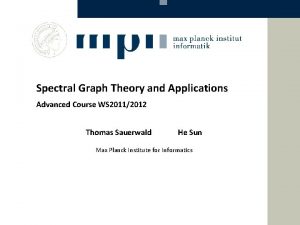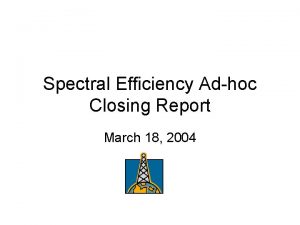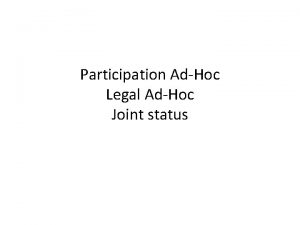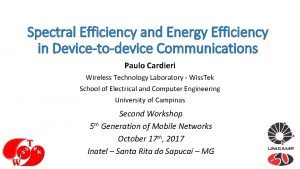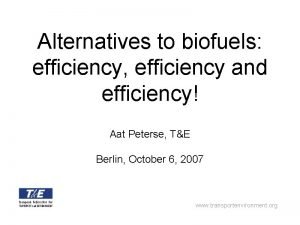Spectral Efficiency Adhoc March 18 2004 Status and









- Slides: 9

Spectral Efficiency Ad-hoc March 18, 2004

Status and Continuation • The ad-hoc group will meet again Thursday, March 19, 2004 at 7: 00 am • In preparation for tomorrow’s ad-hoc meeting participants are requested to focus on Option 1 a and Option 3 a to determine their willingness to buy in on these options. • For Option 3 a, slide 9 provides a “working table” for participants to propose values that they find acceptable. • Participants should “socialize” their thoughts in an attempt to build consensus ahead of the meeting. • The ad-hoc chair would like to propose an additional possible avenue of compromise for people to consider: Consider including, in Option 1 a, a statement to the effect that “The evaluation scenario for spectral efficiency shall include at least x% (e. g. 10%) of user terminals that are moving at speed of 120 km/h and above.

Option 1 a (No technical change but table has been simplified and clarified) The system spectral efficiency of the 802. 20 air interface shall be quoted for the case of a three sector baseline configuration[1]. It shall be computed in a loaded multi-cellular network setting, which shall be simulated based on the methodology established by the 802. 20 evaluation criteria group. It shall consider among other factors a minimum expected data rate/user and/or other fairness criteria, and percentage of throughput due to duplicated information flow. The values shall be quoted on a b/s/Hz/sector basis. The system spectral efficiency of the 802. 20 air interface shall be greater than: Parameter Spectral Efficiency Requirements and Targets Downlink Spectral Efficiency (b/s/Hz/sector) Uplink Required Minimum Desirable Target 1. 2 2. 4 0. 6 1. 2 The spectral efficiency at different mobility speeds should degrade gracefully. [1]Since the base configuration is only required for the purpose of comparing system spectral efficiency, proposals may submit deployment models over and beyond the base configuration.

Option 1 and 1 a Comparison Parameter Spectral Efficiency Requirements and Targets Down. Link Spectral Efficiency (b/s/Hz/sector) Uplink Required Minimum Desirable Target 1. 2 2. 4 0. 6 1. 2

Option 3 In this document, the term “System Spectral Efficiency” is defined in the context of a full block assignment deployment and is, thus, calculated as the average aggregate throughput per sector (bps/sector), divided by the spectrum block assignment size (Hz)( taking out all PHY/MAC overhead). For proposal evaluation purposes, the System Spectral Efficiency of the 802. 20 air interface shall be quoted for the case of a three sector baseline configuration[1] and an agreed-upon block assignment size. It shall be computed in a loaded multi-cellular network setting, which shall be simulated based on the methodology established by the 802. 20 evaluation criteria group. It shall consider, among other factors, a minimum expected data rate/user and/or other fairness criteria, Qo. S and percentage of throughput due to duplicated information flow. [1]Since the base configuration is only required for the purpose of comparing system spectral efficiency, proposals may submit deployment models over and beyond the base configuration.

Option 3 The system spectral efficiency of the 802. 20 air interface shall be greater than the values indicated in table 4 -1. The spectral efficiency at higher speeds than those shown should degrade gracefully. Channel Bandwidth Parameter 1. 25 MHz. @ 3 km/hr 1. 25 MHz. @ 120 km/hr 5 MHz. @ 3 km/hr 5 MHz. @ 120 km/hr DL UL 2. 0 1. 0 0. 75 Spectral Efficiency (b/s/Hz/sector)

Option 3 m (Format change of table in Option 3 to align with table in Option 1 a) The system spectral efficiency of the 802. 20 air interface shall be greater than the values indicated in table 4 -1. The spectral efficiency at higher speeds than those shown should degrade gracefully. Parameter Spectral Efficiency Requirements and Targets Downlink Spectral Efficiency (b/s/Hz/sector) Uplink 3 km/hr 120 km/hr 2. 0 1. 0 0. 75

Option 3 a (Values TBD) • The system spectral efficiency of the 802. 20 air interface shall be greater than the values indicated in table 4 -1. The spectral efficiency at higher speeds than those shown should degrade gracefully. Parameter Spectral Efficiency Requirements and Targets Downlink Spectral Efficiency (b/s/Hz/sector) Uplink 3 km/h [50/120] km/h 3 km/h [50/120 km/h] [1. 2/0. 4] 0. 6 [0. 6/0. 2]

Working Tables for Option 3 a Parameter Spectral Efficiency (b/s/Hz/sector) Spectral Efficiency Requirements and Targets Upper Limits to proposed values Downlink Uplink 3 km/hr 120 km/hr 2. 0 1. 0 0. 75 Spectral Efficiency Requirements and Targets “Estimate” of lower limit of proposed values Downlink Uplink 3 km/h [50/120] km/h 3 km/h [50/120 km/h] [1. 2/0. 4] [0. 6/0. 2]
